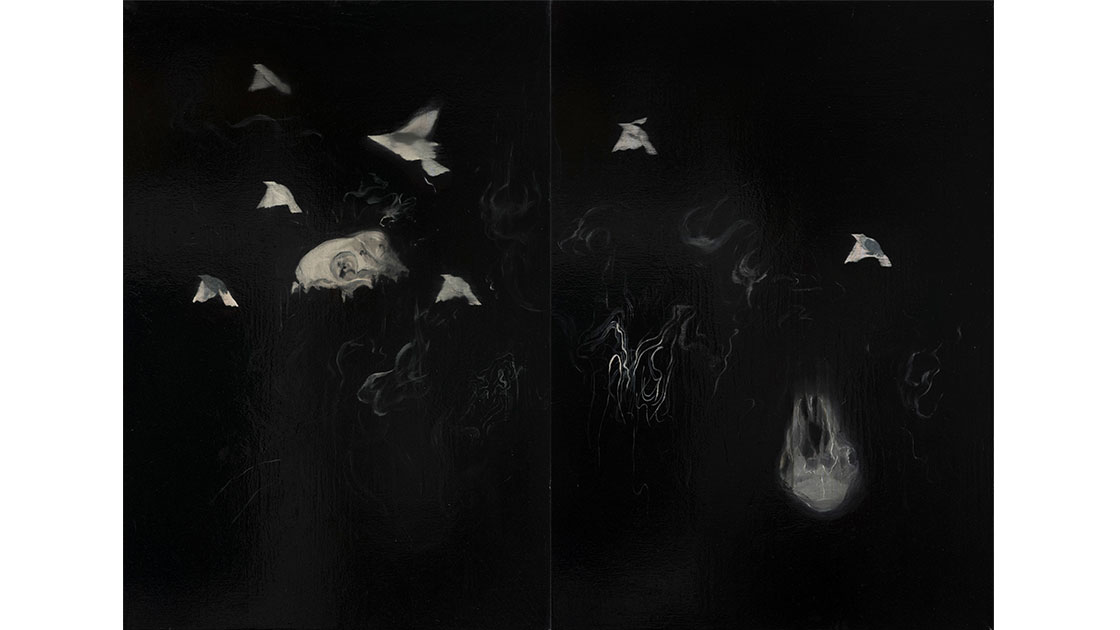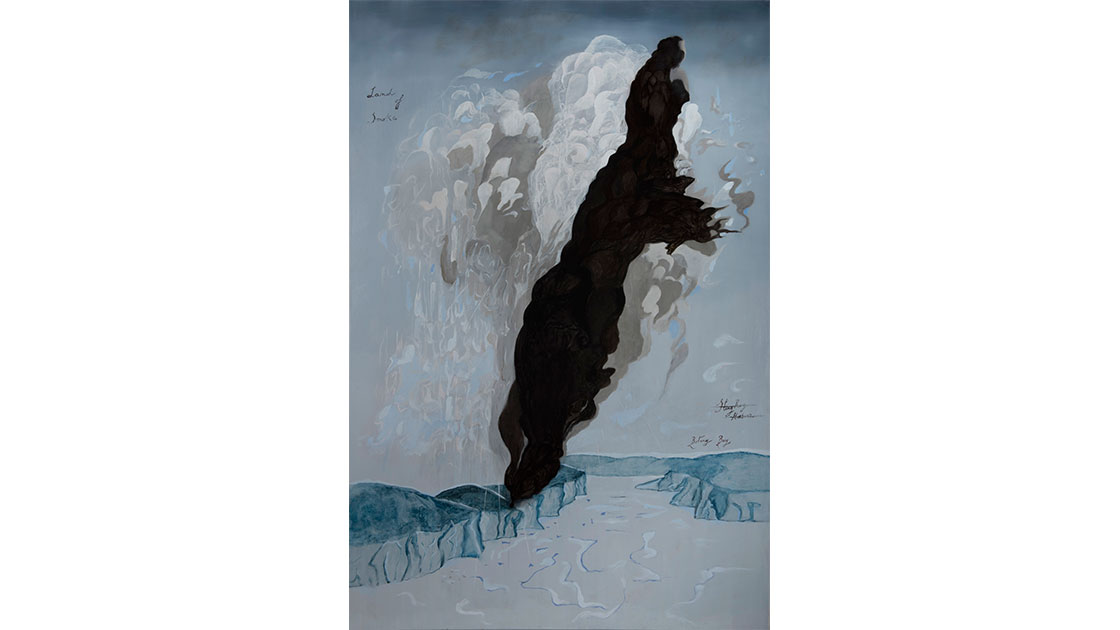Paul Uhlmann
Spirals of smoke eddy voluptuously through the dense black fields of Paul Uhlmann's recent canvases. Caught within these elegant, swirling forms birds hover momentarily in their flight from imminent disaster. There is no panic, instead a stillness prevails in landscape, landscape (birds), a meticulous choreography of elusion. While offering no definitive solutions, Uhlmann's new body of work conjures up a meditative space within which we can ponder our sense of self, imagine pathways of escape and ascertain strategies for renewal.
Just as Gustav Mahler claimed, ‘The symphony is a world; it must contain everything,’ so Uhlmann draws his experiences into the cosmos of his paintings. The summer of bushfires we have just experienced, the document of Captain James Cook’s first ill-fated meeting with local Aboriginal people in Botany Bay, the sheep skulls on his father-in-law’s farm at Boyup Brook, all coalesce into lucidity in his impressive works. Emerging from the metaphorical black of “endless becoming,” forms take shape momentarily before eliding into others and rearticulating. ‘My intention is to reveal the power of seeing something for the first time,’ Uhlmann explains, documenting how those fleeting experiences, more precious than we realise, shape our experience. According to the French philosopher Merleau-Ponty, ‘… the perceived world endures only through the reflections, shadows, levels, and horizons between things’[1], and it is in that space between that meaning is established.
landscape, landscape (smoke) was born from the Armageddon of the summer bushfires, the elements that emerge from its enveloping blackness are the residue of the landscape. When Cook first encountered the Great Southern Land, he described it as a “continent of smoke,” responding to the fires of Aboriginal families managing their land. After our disastrous summer that comment echoes in our psyche as we identify what survives, what remains to give new life and what reminds us of all we have lost. For Uhlmann, landscapes are repositories of their component parts — of land and animals, the sky and its birds, the sea pulsing with life — and we become part of that fusion. They are not a stage on which to act out a role, but instead, they operate as a field within which to be, to reflect, and to know. They are the antithesis of traditional landscapes, viewed from outside, fixed and distant. These landscapes are internal, involving and absorbing. Created through our interactions with the skulls, birds, and filigree of smoke, traced like an X-ray on a sensitised plate, their presence in our consciousness is charted in Merleau-Ponty’s ‘space between’ and find meaning there.
These documents, written in paint, are ‘… a form of language, of writing, of poetry,’ Uhlmann explains. As a maker of artist-books the unfolding of a narrative is ingrained in his practice, but in this new body of work the interweaving of imagery, story and text has coalesced in new ways. On discovering the record of Cook’s first contact with Indigenous Australians in Stingray Harbour (later renamed Botany Bay to acknowledge the discoveries of Joseph Banks), he intertwined the recorded violence of the first contact with Aboriginal Australians with the sustenance the British received from the plentiful Stingray and the recent summer bushfires. land of smoke (Gweagal Bidjigal) aligns these ideas within a narrative that questions the fractured relationships between the European interlopers and Aboriginal peoples. Referencing the work of Anselm Kiefer, whose history paintings brought issues of German national identity to the forefront in the 1980s, Uhlmann invites us (in a less dogmatic way) to ponder on the question of how the issues of fire and smoke, sustainability and reconciliation can be resolved in contemporary Australia.
Uhlmann is a meticulous craftsman who wields his sophisticated armoury of skills with a rigorous intellect. As the Finnish architect and theorist Juhani Pallasmaa explains, working with materials and a knowledge of their properties is an intellectual activity, which he describes as the ‘thinking hand’: ‘a metaphor for the characteristic independence and autonomous activity of all our senses as they constantly scan the physical world. Many of our most crucial skills are internalised as automatic reactions that we are not consciously aware of. Even in the case of learning skills, the sequence of movements in a task is internalised and embodied rather than understood and remembered intellectually.’[2] This tacit wisdom is at the core of Uhlmann’s practice. They are the trigger for his new works about ‘place, embodiment and impermanence’ and emerge from what he describes as a ‘state of progress,’ of unfolding and becoming. Rooted in the practices of art, attuned to the current eddies of fortune and misadventure, steeped in the history of humanity’s engagement with their environment and conscious of his responsibilities as a guardian and steward of this place, Paul Uhlmann provides us with the resources and the inspiration to rethink the world we wish to inhabit.

















